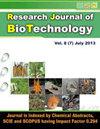印度西哈里亚纳邦圣林中的糙叶木入侵和生态优势
IF 0.2
Q4 BIOTECHNOLOGY & APPLIED MICROBIOLOGY
引用次数: 0
摘要
本研究在哈里亚纳邦半干旱地区的圣林进行。糙叶树是最常见的入侵植物物种之一,会对生态造成不同程度的影响。在哈里亚纳邦,广阔的半干旱条件非常有利于鹅掌楸的入侵,包括该邦的神圣丛林。因此,本研究调查了哈里亚纳邦两个神圣丛林园(即 Daya(SG-I)和 Kharkada(SG-II))中不同入侵程度的箭毒树种群结构。研究还通过评估不同的生态参数,如植被的分析特征以及四种多样性指数(香农-韦纳指数、辛普森指数、皮鲁指数和马加勒夫指数),考察了入侵树木对本地植物区系的影响。研究结果表明,原生植物入侵较少的圣林(SG-I)具有较高的原生植物物种密度和基部面积,在选定的多样性指数中具有显著的数值,因此与入侵严重的地点(SG-II)相比,圣林的植物生长更为茂盛。由此可以得出结论,哈里亚纳邦圣林的本地植物多样性由于箭毒榛入侵的加剧而岌岌可危,因此需要采取有效的管理策略。本文章由计算机程序翻译,如有差异,请以英文原文为准。
Prosopis juliflora invasions and ecological dominance in the sacred groves of Western Haryana, India
The present study was conducted in the sacred groves of Haryana in the semi-arid regions. Prosopis juliflora is one of the most common invasive plant species and has varying degrees of ecological consequences. In Haryana, the vast semi-arid conditions has ideally favoured the invasion of P. juliflora including the sacred groves of the State. Therefore, the present study investigated the population structure of the P. juliflora in the two sacred groves of Haryana i.e. Daya (SG-I) and Kharkada (SG-II) with different degrees of invasion. The impact of the invasive tree on the native flora was also examined by the assessment of different ecological parameters like analytical characteristics of vegetation along with four diversity indices (Shannon-Weiner Index, Simpson Index, Pielou Index and Margalef Index). The results of the study revealed that the sacred grove with low Prosopis invasion (SG-I) had high density and Basal area of native plant species as having significant values for the selected diversity indices and thus is better flourished in comparison to the highly invaded site (SG-II). It can be concluded that the native phytodiversity of the sacred groves of Haryana is in peril due to increasing P. juliflora invasion, thus efficient management strategies are required in this direction.
求助全文
通过发布文献求助,成功后即可免费获取论文全文。
去求助
来源期刊

Research Journal of Biotechnology
BIOTECHNOLOGY & APPLIED MICROBIOLOGY-
CiteScore
0.60
自引率
0.00%
发文量
192
期刊介绍:
We invite you to contribute Research Papers / Short Communications / Review Papers:
-In any field of Biotechnology, Biochemistry, Microbiology and Industrial Microbiology, Soil Technology, Agriculture Biotechnology.
-in any field related to Food Biotechnology, Nutrition Biotechnology, Genetic Engineering and Commercial Biotechnology.
-in any field of Biotechnology related to Drugs and Pharmaceutical products for human beings, animals and plants.
-in any field related to Environmental Biotechnolgy, Waste Treatment of Liquids, Soilds and Gases; Sustainability.
-in inter-realted field of Chemical Sciences, Biological Sciences, Environmental Sciences and Life Sciences.
-in any field related to Biotechnological Engineering, Industrial Biotechnology and Instrumentation.
-in any field related to Nano-technology.
-in any field related to Plant Biotechnology.
 求助内容:
求助内容: 应助结果提醒方式:
应助结果提醒方式:


